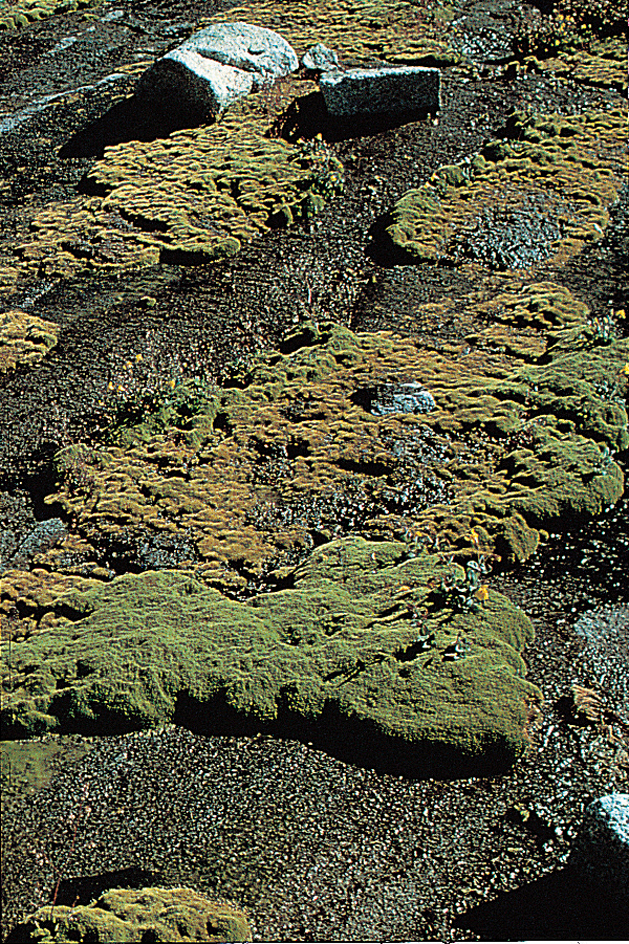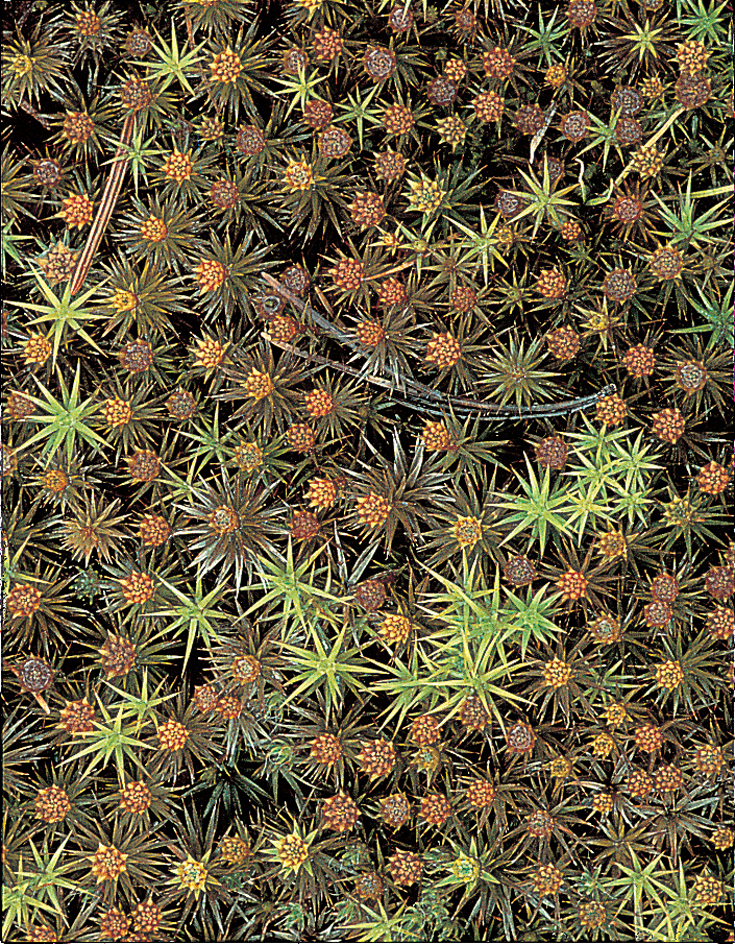Moss is any of a variety of small, green, nonflowering plants found throughout the world. Mosses tend to grow close together in large numbers. They often form soft, dense mats on rocks, trees, or soil. Most mosses live on land in moist, shady places. But some are found in dry environments, and others grow in lakes, ponds, or rivers. Mosses generally measure less than 6 inches (15 centimeters) in height.

There are more than 9,000 species of mosses. Distinctive groups of species include granite mosses and peat mosses. Granite mosses are found on rocks in mountainous regions and the Arctic. Peat mosses grow in moist woodlands and in such marshy areas as bogs and fens. Other distinctive mosses include the haircap moss and the feather moss. Haircap mosses grow chiefly on soil, often in thick tufts. Feather mosses sometimes form dense carpets covering large areas of ground.
Other kinds of plants have the word moss as part of their common name but are not really mosses. These plants include Spanish moss, reindeer moss, and club mosses. See Club moss ; Reindeer moss ; Spanish moss .
The structure of mosses.
Unlike flowering plants, mosses do not have true roots. But they have threadlike structures called rhizoids that anchor the plants and absorb water and nutrients. Most plants have short stems that produce rhizoids. The stems are covered by tiny leaves in a spiral pattern. The leaves absorb water and nutrients directly through their surface from the atmosphere. These leaves also contain chlorophyll, a green substance the plant uses to make food. In many cases, a vein runs the length of the leaf from the stem to the tip. This vein, called the costa or midrib, strengthens the leaf and transports food and water.

How mosses live.
Mosses often grow in moist or aquatic environments, and they are more abundant in old forests than in young ones. However, certain mosses can survive extremely dry conditions. Their need for water changes with the amount of water available in the environment. During dry periods, mosses may turn dull brown and appear dead. But they become green and fresh-looking again as soon as it rains. Other, short-living mosses are found in prairies and other habitats that have exceptionally dry summer months. These mosses grow during the rainy months of spring and die when summer begins.
Mosses grow and reproduce in two phases—as sporophytes and gametophytes. This kind of life cycle is called alternation of generations.
During one phase, the moss plant is called a gametophyte. The gametophyte is the plant familiarly recognized as the moss. A mature gametophyte produces gametes (male sperm cells or female egg cells). The gametes form in special organs that grow from the top or along the side of the stem. The organs that produce sperm cells are called the antheridia. Those that produce egg cells are known as the archegonia. About half of all mosses bear both antheridia and archegonia on the same plant. When the antheridia become ripe and damp enough, they burst and release hundreds of sperm cells. Some of these cells may reach an archegonium, where one may unite with an egg cell to form a zygote.
The formation of the zygote begins the second phase of the moss life cycle. During this phase, the zygote develops into a sporophyte that remains attached to the gametophyte. It consists of a long, erect stalk called a seta, with a podlike capsule at the end. Microscopic structures called spores form in the capsule. A capsule may contain from four to more than a million spores, depending on the species.

In most mosses, the mouth of the capsule is covered by a lidlike operculum. In peat mosses, when the spores ripen, the operculum comes off explosively and the spores shoot into the air. In most other mosses, tiny toothlike structures around the mouth of the capsule control the release of spores. These structures, called the peristome, remain closed under wet conditions. In dry conditions, they open to discharge spores. If a spore falls on a damp area, it may sprout into a branching, threadlike protonema. Buds from the protonema then grow into gametophytes, completing the life cycle.
The importance of mosses.
Mosses play an important part in the lives of many small animals. A number of small animals, including certain mites and spiders, live in mosses. Some birds use moss fibers to build or line their nests. Weevils in New Guinea have been found with mosses growing on their backs. The mosses serve as camouflage for these insects.

Mosses also help the environment. Some types, including peat mosses, can hold large quantities of water. This characteristic helps prevent soil erosion and flooding. Mosses also store minerals and other nutrients. After mosses die, they decompose (break down) and release nutrients. Other plants then use these nutrients to grow.
In various regions of the world, decaying mosses and other plant matter accumulate in low-lying areas over numerous years and form peat. Many such peat lands exist in Canada, Russia, and northern Europe. See Peat .
Peat mosses have a spongy texture and are absorbent. Many gardeners use them to keep young plants from drying out. Peat moss is also used in the cultivation of mushrooms. In the past, some American Indians made diapers out of peat mosses. During World War I (1914-1918), peat mosses were used as dressings for wounds. See Peat moss .
